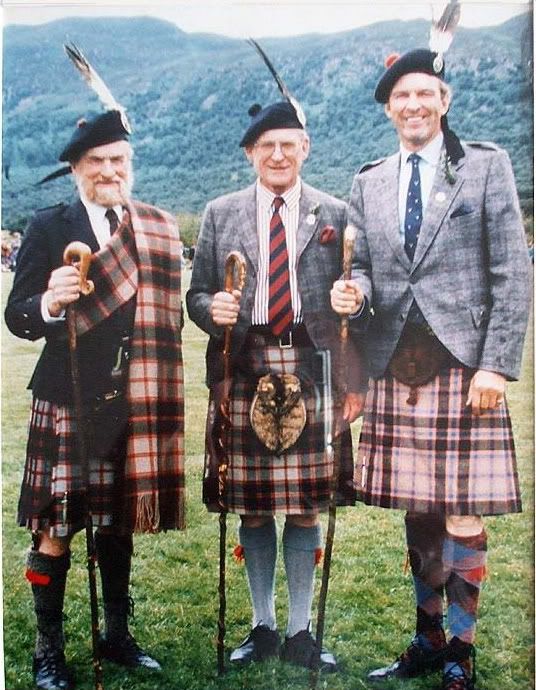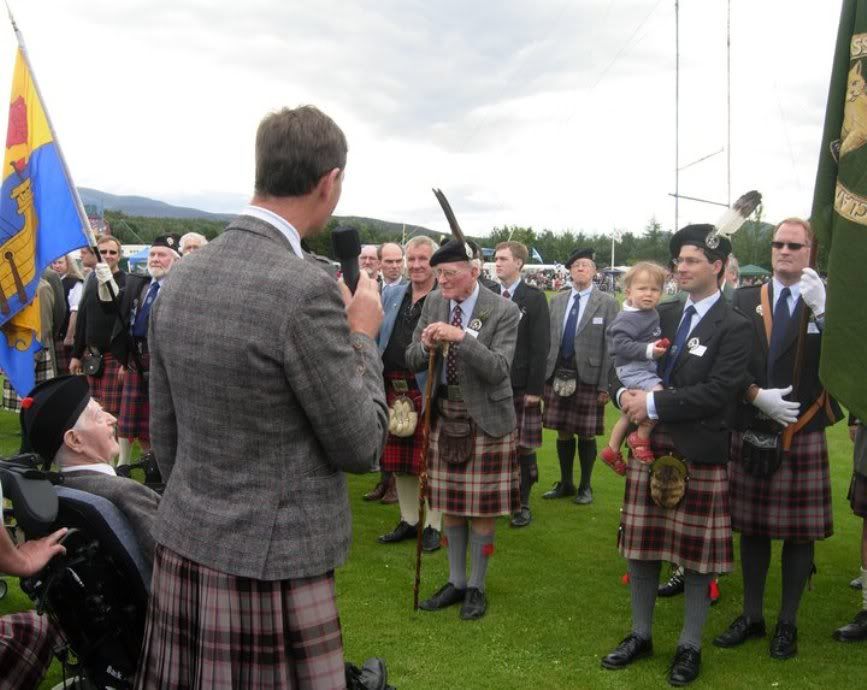|
-
27th February 14, 12:07 PM
#1
Septs
Just out of academic curiousity, who decides which family is a sept of a clan? Am I correct in my understanding that a chieftan (wearing 2 feathers) is the head of a sept? And how is this person chosen? I looked on the Lyon website but did not find any specific answers.
Geoff Withnell
"My comrades, they did never yield, for courage knows no bounds."
No longer subject to reveille US Marine.
-
-
27th February 14, 12:34 PM
#2
The Chief is in charge of his Clan. If he wants septs and chieftans, then so be it.
-
The Following 2 Users say 'Aye' to Chas For This Useful Post:
-
27th February 14, 02:18 PM
#3
I agree with Chas.
I can say with certainty that many of the septs (or associated families, as Cluny (our Chief) and clan members prefer to say) of the Clan Macpherson have been traditionally associated with the clan based upon particular historical aspects that have taken place throughout Clan Macpherson history. However, it is extremely beneficial and far more accurate, genealogical speaking, to find out where in Scotland your ancestors actually originated from and then go from there. Many of the associated families of the Clan Macpherson simply lived on Clan Macpherson lands in Badenoch as tenants of the Chief, thus, pledging their loyalty and support to him and the clan. Genealogical research is an invaluable tool in this regard as well.
I can also say with certainty that within the structure, heritage and cultural/tribal traditions of the Clan Macpherson, we often use the Scottish Gaelic word of sliochd, which means "race of, tribe, descendents, or even clan." A sliochd is a bit like an associated family/sept, but not quite, since the sliochd within the clan are already Macphersons to begin with and are related to the Chief. Sliochd is a wee bit more like a "clan within a clan," or a cadet branch that accurately designates and differentiates one group of Macphersons from the next, since some families may be more "prominent" than others, which is largely dependent upon their genealogy and how closely related they are to the Chief and his immediate family.
Example:
"The Genealogy: Structure and Evolution of the Clan Macpherson
The Invereshie Book Genealogy is a remarkable document. It contains so much information about the organisation of the Clan Macpherson by blood descent, marriage and territorial holding that it is virtually a manual on the anatomy of the Clan Macpherson. As such it is probably unique in Highland archives, and must be regarded as the principal document upon which any future history of the clan must be founded.
The document announces itself with the title, "The Genealogies of the Macphersons since the Three Bretheren from whom the family is called Sliochd an triùir Bhàithrean." It is organised in three parts; one for the descendants or sliochd of each of the brothers, and each part extends through ten to twelve generations, from about 1350 when Ewan, father of the three brothers, was living, to about 1700. The procedure adopted in each part is to trace the senior family patrilineally, that is, from father to son, mentioning daughters and younger sons from whom branches of the family descended, and then to trace the descent of the branches from the oldest to the youngest in turn.
Kenneth, the first of the three brothers, is introduced as “Kenneth, eldest lawful son of Ewan Macpherson of Cluny." His sliochd is then followed to Duncan Macpherson of Cluny who died in 1722. The genealogist continues with the statement: “Having spoken of the posterity of Kenneth Macpherson in a direct line, now remains to speak of the severall branches descended lineally of the said Kenneth, and I shall begin with them as they gradually descended of the said stock.” The oldest branches of “Sliochd Kynich” (Sliochd Choinnich) were “Clan vic Ewan duy” (Clann Mhic Eóghain Duibh), “Clan vic Ewan Taylor” (Clann Mhic Eóghain Tàillear), and the family of Brin: these he dismisses with the comment that he has "at present no particular and gradual genealogy." He then proceeds to describe the detailed genealogies of the Macphersons of Essich, Crubenmore‐Breakachie and Nessintullich, Pourie, Bellachroan, Ardbrylach and Glengoynack‐Pitmain, Blaragie‐beg, Crathie‐Croy, Pittourie, Old Dalrady, Kingussie‐beg‐Laggan, Nood [Nuide] and Benchar.
It was from Nood [Nuide], the youngest and closest branch of Sliochd Choinnich that the present line of Macpherson chiefs sprang in the eighteenth century. The descent from John, the second of the three brothers, begins with an account of the Macphersons of Glenelg and Rothiemurchus, a family in Bealid, and another in “Strathern” [Strathdearn], representatives of which are mentioned as being contemporary with the genealogist. This is followed by full accounts of the Macphersons of Pitmain [Pitmean], Garvamore‐Inverroy and Shiromore, Bealid, Coronach and Invernahaun [Invernahavon], Stramasie [Strathmashie], Tirfodown, Invertromie, Pitchirn and Cluny.
The descent from Gillès (Gillies), third of the three brothers, gives a detailed description of the Macphersons of Invereshie, New Dalrady and Killihuntly, Knappach, Phoyness [Phoness], Coraldie and Etterish.
The three major divisions of the clan are listed as “Sliochd Kynich” (Kenneth), “Sliochd Iain” (John), and “Sliochd Gilliosa” (Sliochd Ghill‐Iosa, Gilles), and there is plenty of corroborating evidence in the records of the seventeenth century, and in the manner in which the officer corps of Ewan Macpherson of Cluny's (Cluny of the '45) regiment in the Jacobite Rising of 1745 was organised, to show that these were indeed functional divisions. The patrilineal structure of Sliochd an trùir Bhráithrean is illustrated in the accompanying diagrams (pp 19, 31). It should be noted that the surname and territorial designation “Macpherson of Cluny”, as applied to Ewan, the father of the three brothers, is being applied retroactively by the genealogist: the surname was not in use till the early fifteenth century, and Cluny was acquired even later. Both John and Gilles are mentioned as sons of "Ewan Macpherson, Chieftain of the Clanchattan," a title contested between the Macphersons of Cluny and the Mackintosh chiefs. Sir Aeneas Macpherson of Invereshie, FSA (Scot), was an eminence gris behind Duncan Macpherson of Cluny in one phase of this contest before the Whig Revolution sent him on his travels, but the tribal designation may have some validity..."
-Dr. Alan G. Macpherson, of St. John's, Newfoundland, Clan Macpherson Historian
Last edited by creagdhubh; 27th February 14 at 02:22 PM.
-
-
28th February 14, 08:44 AM
#4
Kyle,
Really wasn't worried about any personal issue. It's just there seemed to be a hole in the system. Chiefs are recognized by Lord Lyon. Armigers are recognized by Lord Lyon. While there is some discussion of who is a "leading member" of a Family in the guidance for a Derbhfine, at least on the Lyon webpage, there is no mention of how a chieftain is recognized, or a sept. So if I understand correctly, hypothetically if I and my brothers and our sons and grandsons became very prolific, and Withnell became a common name in Clan Davidson, the then Chief of Davidson could say Withnell was a sept, and the current head of the family was the Chieftain?
Geoff Withnell
"My comrades, they did never yield, for courage knows no bounds."
No longer subject to reveille US Marine.
-
-
28th February 14, 09:04 AM
#5
 Originally Posted by Geoff Withnell

Kyle,
Really wasn't worried about any personal issue. It's just there seemed to be a hole in the system. Chiefs are recognized by Lord Lyon. Armigers are recognized by Lord Lyon. While there is some discussion of who is a "leading member" of a Family in the guidance for a Derbhfine, at least on the Lyon webpage, there is no mention of how a chieftain is recognized, or a sept. So if I understand correctly, hypothetically if I and my brothers and our sons and grandsons became very prolific, and Withnell became a common name in Clan Davidson, the then Chief of Davidson could say Withnell was a sept, and the current head of the family was the Chieftain?
Perhaps, Geoff. However, not all "heads" of septs are Chieftains. Chieftains, from a tradtional standpoint and using my own clan structure as a living example, are closely related to the Chief by blood, but are not members of his immediate family. The Chieftains of the Clan Macpherson, of which I will discuss further below, are Macphersons themselves and bear the "Macpherson" surname. They are not members of associated families, or septs.
Associated families of Highland Clans (Septs) are traditionally approved by the Chief. Therefore, in this particular case (completely separate from Chiefship and Armigerous persons), it is a clan-specific matter and not something that really concerns the Court of the Lord Lyon. Within the Clan Macpherson, and there's no doubt that this may vary from one Highland Clan to the next, but probably not too terribly much, the Chieftains are the heads of the most senior, cadet branches of the clan.
Example:
Lachlan Macpherson of Glentruim and Alastair Macpherson of Pitmain are both Chieftains representing the two most senior cadet branches of the Clan Macpherson. Genealogically speaking, their families are the closest in relation to that of the Chief's, Sir William Macpherson of Cluny. Therefore, their familes are the most senior within the clan (next to the Chief and his family, of course) with a Chieftain representing each cadet branch. Lachlan and Alastair are both armigerous (as were their fathers) and their Arms were indeed granted by the Lord Lyon. Lachlan and Alastair both wear their own crest (in the form of a circlet) on their bonnets, along with two tall, eagle feathers.
Alastair Macpherson of Pitmain (far right). Lachlan's father, the late Euan Macpherson of Glentruim is on the left of Cluny (center).

Lachlan Macpherson of Glentruim standing left of Cluny at the annual Clan Macpherson Gathering and Rally in Newtonmore, Inverness-shire. Pitmain is standing on the right of Cluny, yet he his out of view in this particular photo.

Last edited by creagdhubh; 28th February 14 at 09:23 AM.
-
-
28th February 14, 06:44 PM
#6
Thank you.
I'm an engineer, I get an itch to understand how something works, and I can't rest until I scratch it.
Geoff Withnell
"My comrades, they did never yield, for courage knows no bounds."
No longer subject to reveille US Marine.
-
The Following 2 Users say 'Aye' to Geoff Withnell For This Useful Post:
 Posting Permissions
Posting Permissions
- You may not post new threads
- You may not post replies
- You may not post attachments
- You may not edit your posts
-
Forum Rules
|
|



















Bookmarks